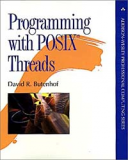Книга: Programming with POSIX® Threads
3.1 Invariants, critical sections,and predicates
3.1 Invariants, critical sections,and predicates
"I know what you're thinking about,"
said Tweedledum; "but it isn't so, nohow."
"Contrariwise," continued Tweedledee,
"if it was so, it might be; and if it were so, it would be;
but as it isn't, it ain't. That's logic."
Invariants are assumptions made by a program, especially assumptions about the relationships between sets of variables. When you build a queue package, for example, you need certain data. Each queue has a queue header, which is a pointer to the first queued data element. Each data element includes a pointer to the next data element. But the data isn't all that's important—your queue package relies on relationships between that data. The queue header, for example, must either be NULL or contain a pointer to the first queued data element. Each data element must contain a pointer to the next data element, or NULL if it is the last. Those relationships are the invariants of your queue package.
It is hard to write a program that doesn't have invariants, though many of them are subtle. When a program encounters a broken invariant, for example, if it dereferences a queue header containing a pointer to something that is not a valid data element, the program will probably produce incorrect results or fail immediately.
Critical sections (also sometimes called "serial regions") are areas of code that affect a shared state. Since most programmers are trained to think about program functions instead of program data, you may well find it easier to recognize critical sections than data invariants. However, a critical section can almost always be translated into a data invariant, and vice versa. When you remove an element from a queue, for example, you can see the code performing the removal as a critical section, or you can see the state of the queue as an invariant. Which you see first may depend on how you're thinking about that aspect of your design.
Most invariants can be "broken," and are routinely broken, during isolated areas of code. The trick is to be sure that broken invariants are always repaired before "unsuspecting" code can encounter them. That is a large part of what "synchronization" is all about in an asynchronous program. Synchronization protects your program from broken invariants. If your code locks a mutex whenever it must (temporarily) break an invariant, then other threads that rely on the invariant, and which also lock the mutex, will be delayed until the mutex is unlocked— when the invariant has been restored.
Synchronization is voluntary, and the participants must cooperate for the system to work. The programmers must agree not to fight for (or against) possession of the bailing bucket. The bucket itself does not somehow magically ensure that one and only one programmer bails at any time. Rather, the bucket is a reliable shared token that, if used properly, can allow the programmers to manage their resources effectively.
"Predicates" are logical expressions that describe the state of invariants needed by your code. In English, predicates can be expressed as statements like "the queue is empty" or "the resource is available." A predicate may be a boolean variable with a TRUE or FALSE value, or it may be the result of testing whether a pointer is NULL. A predicate may also be a more complicated expression, such as determining whether a counter is greater than some threshold. A predicate may even be a value returned from some function. For example, you might call select or poll to determine whether a file is ready for input.
- Predicates
- Разработка приложений баз данных InterBase на Borland Delphi
- Open Source Insight and Discussion
- Introduction to Microprocessors and Microcontrollers
- Chapter 6. Traversing of tables and chains
- Chapter 8. Saving and restoring large rule-sets
- Chapter 11. Iptables targets and jumps
- Chapter 5 Installing and Configuring VirtualCenter 2.0
- Chapter 16. Commercial products based on Linux, iptables and netfilter
- Appendix A. Detailed explanations of special commands
- Appendix B. Common problems and questions
- Appendix E. Other resources and links




